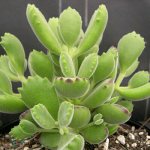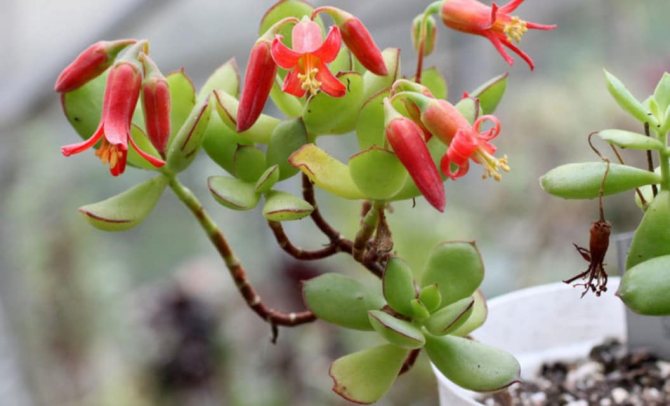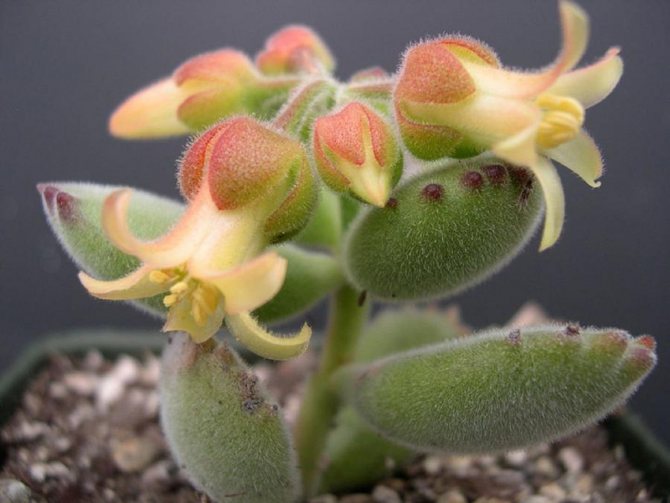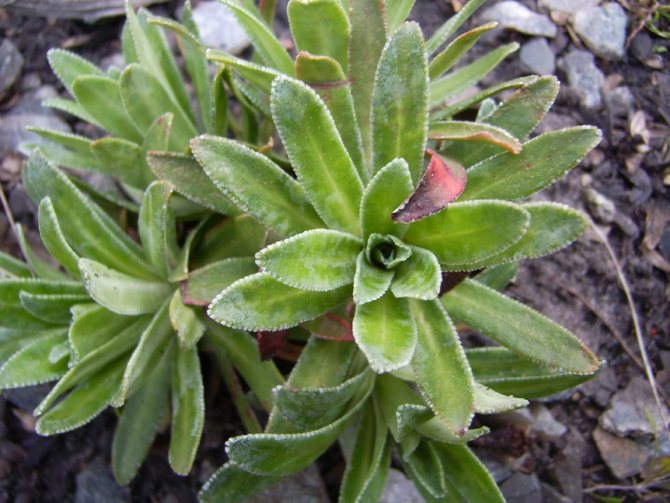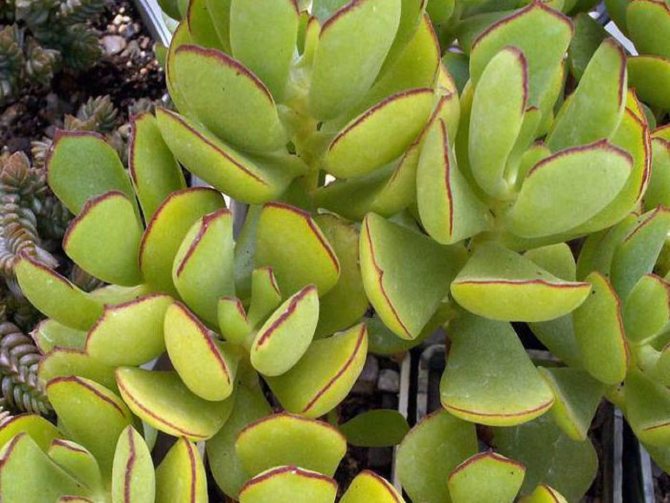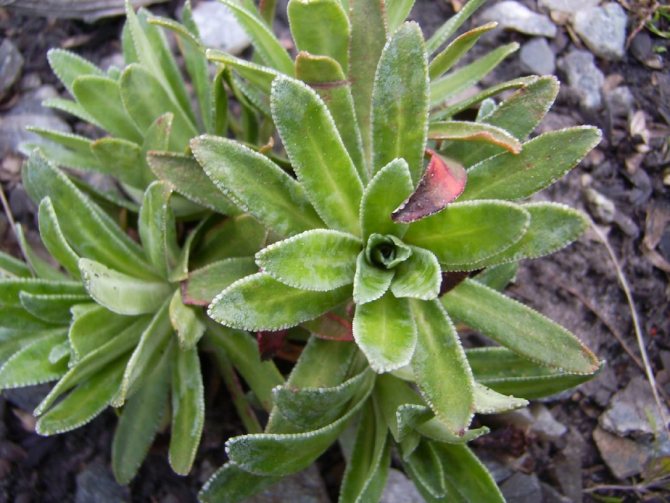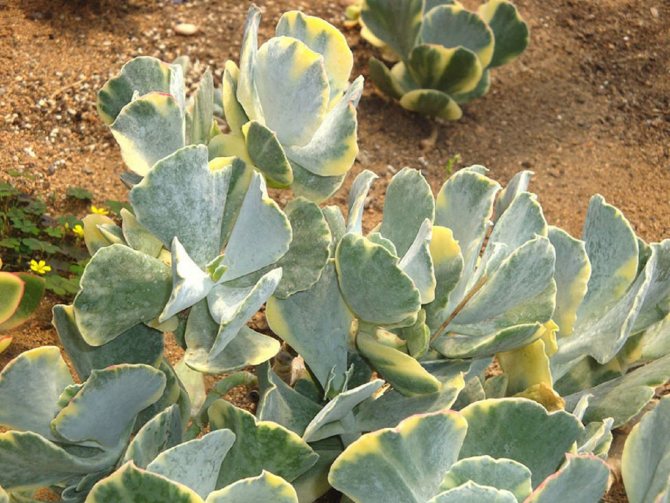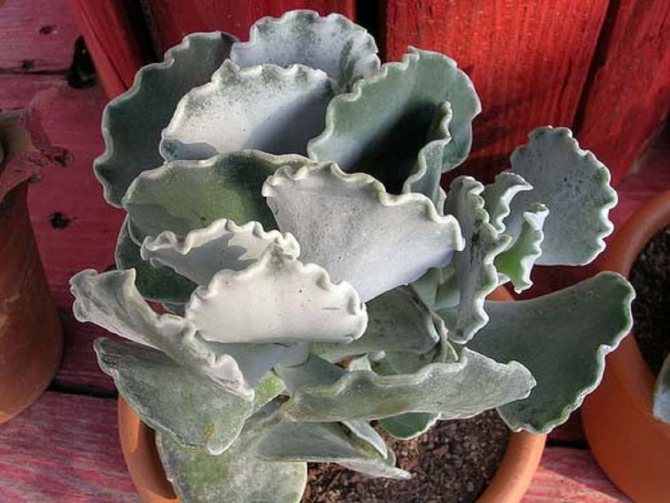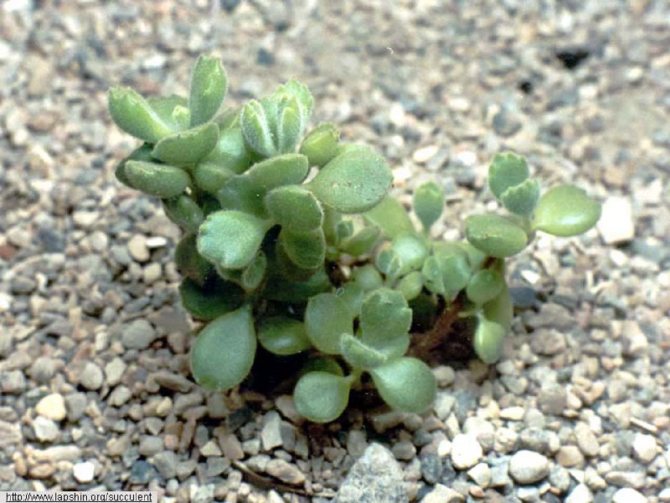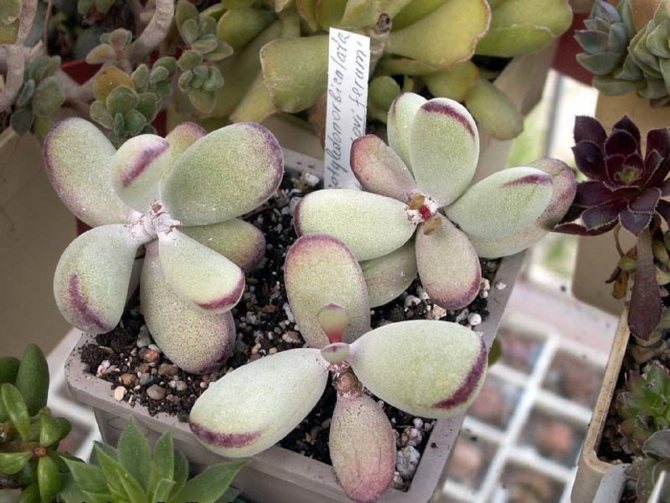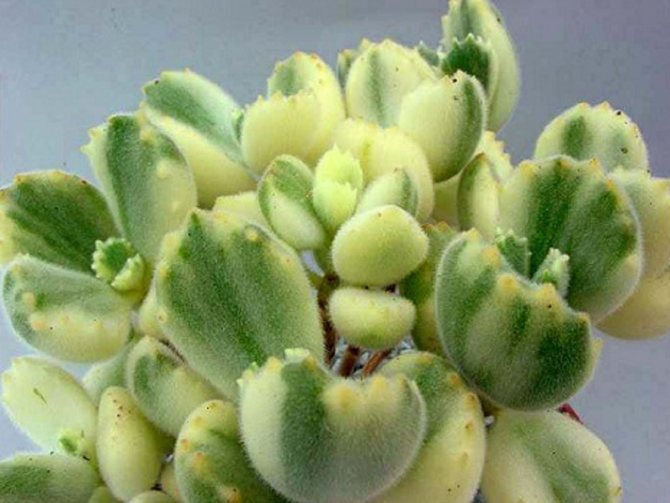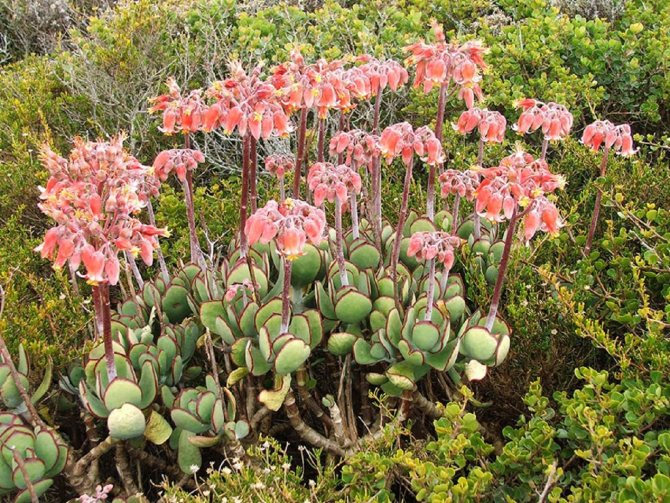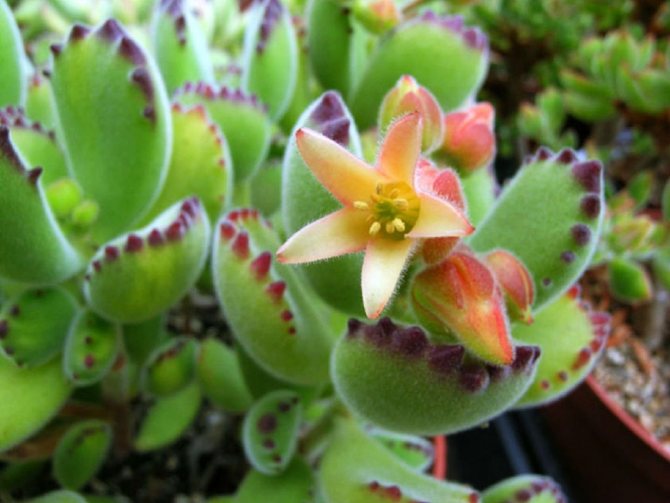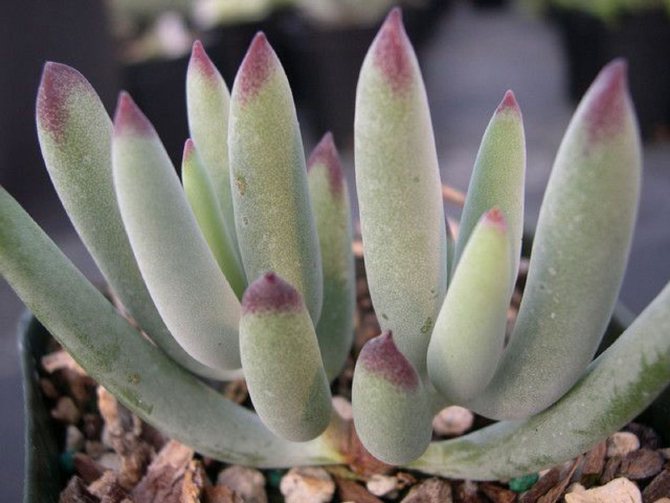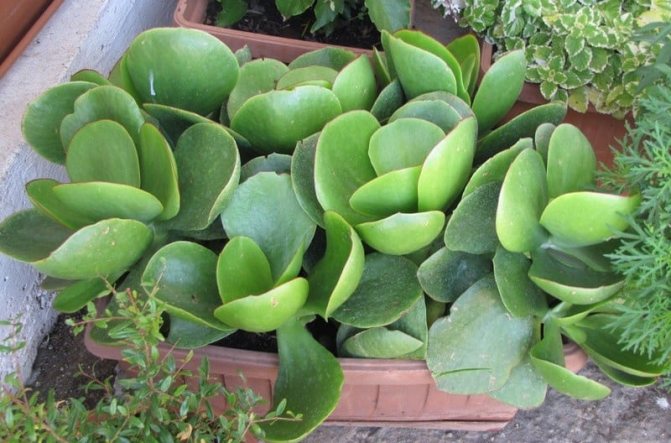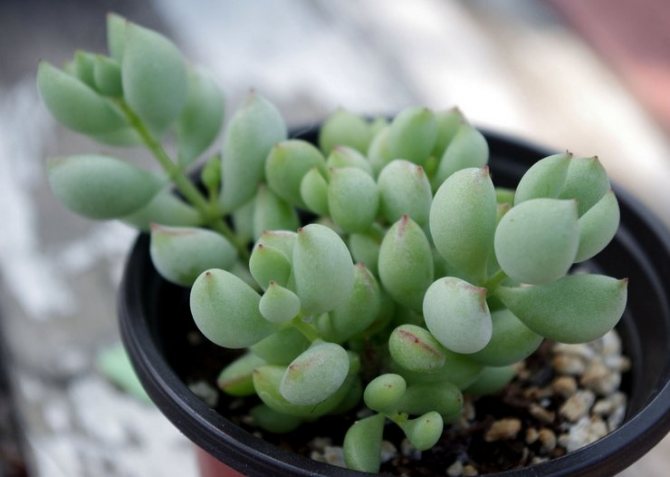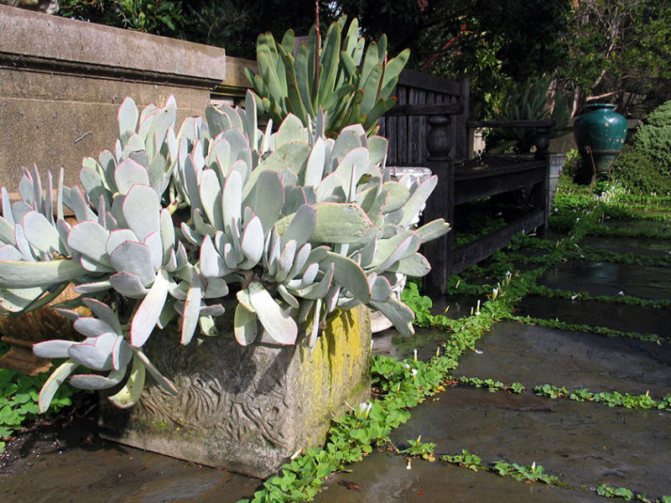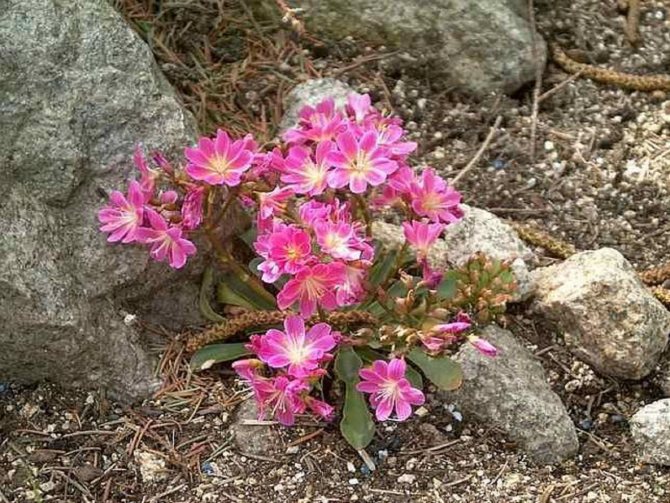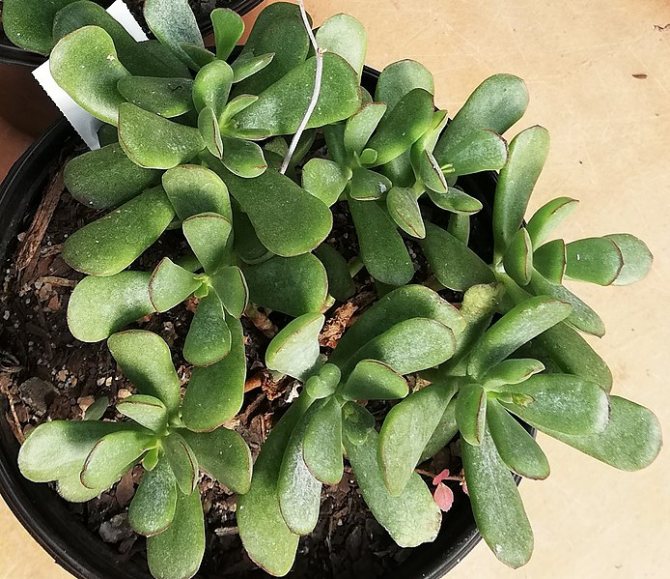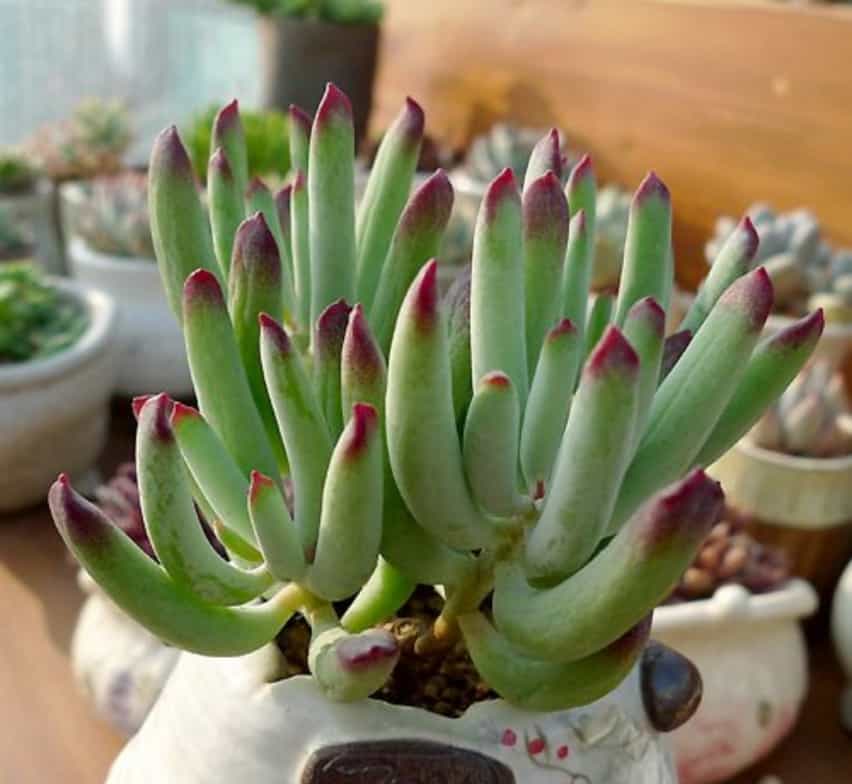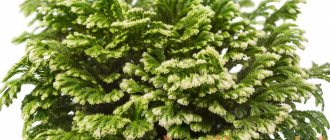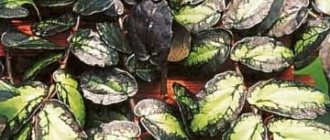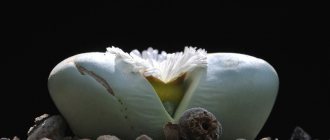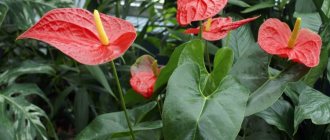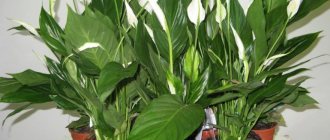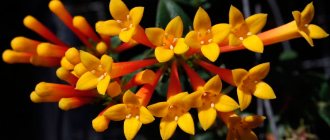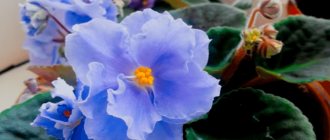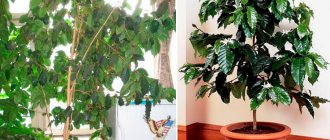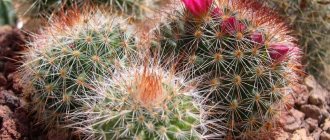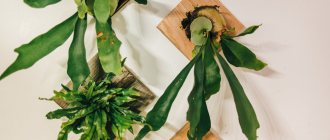The small genus Cotyledon belongs to the Tolstyankov family. According to various sources, there are from 10 to 50 plant species. It is very unpretentious in care, therefore it is common among amateur flower growers. Does not require special knowledge of care. It grows well under basic conditions.
In nature, it grows on the Arabian Peninsula, Ethiopia and South America. All representatives of the genus Cotyledon are short shrubs. Has a very high fragility of the stems. Over time, the stems become lignified. The root system is fibrous. The leaves themselves are petiolate or short-petiolate, opposite, each subsequent pair on the stem is located, as a rule, at 90 degrees to the previous one. Some species form rosettes. Peduncles appear either from the tops of the plants or from the rosettes.
Cotyledon description
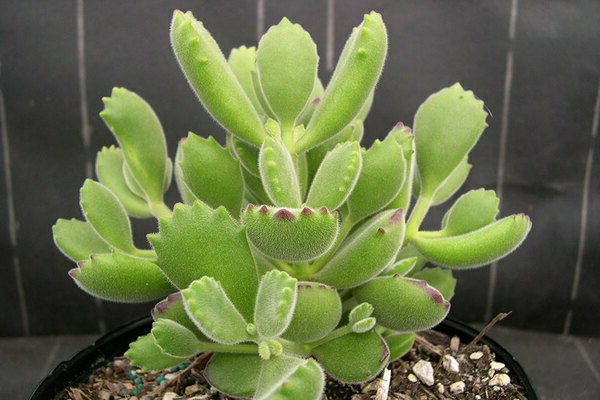
All cotyledons are small plants, the largest specimens found in nature do not exceed one and a half meters. The stems of the plants are thick, but fragile; they gradually lignify and change from green to brownish. The leaves are fleshy and juicy, the petiole is either not at all, or it is very short. The shape and size of leaves in different plants can be very different: there are plants with round, oval, diamond-shaped, lanceolate leaves. The color of the leaves is both monochromatic and variegated, and the surface of the leaf plate is covered with small hairs. The root system of cotyledons is fibrous and located close to the surface, therefore, when growing these plants at home, they do not require deep containers.
Cotyledon blooms in summer, its flowers, located on long plump peduncles, resemble bells collected in umbrella-shaped inflorescences. Flowering, as a rule, is abundant and prolonged, after its end, seed pods are formed in place of flowers, filled with a large number of small round seeds.
Bloom
Only if the requirements for care are met, with sufficient illumination and correct placement, does the cotyledon acquire a decorative appearance, and long peduncles appear from Marchon which buds are formed.
Although succulent is unpretentious in care, if one of the conditions is not met, you should not expect it to bloom.
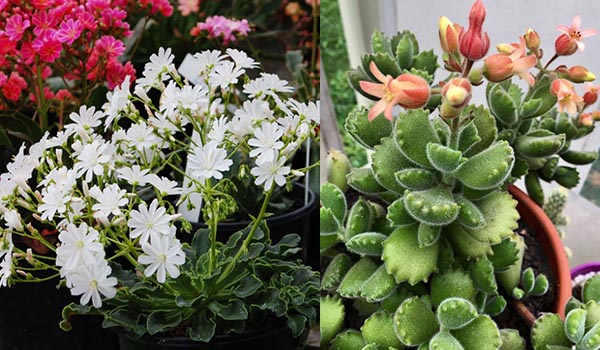

Cotyledon care
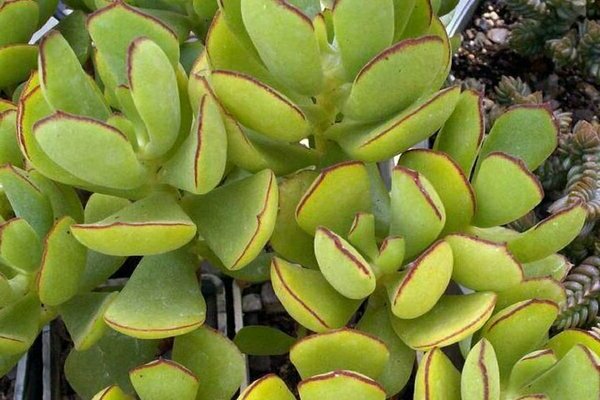

Cotyledon is unpretentious, and if you follow the rule of caring for the plant, then there will be no problems with it.
This plant needs a long daylight hours, and unlike most indoor plants, cotyledon prefers direct rather than diffused sunlight, so a southeast, south or southwestern window sill will be the best place for it. At the same time, the plant is able to grow in another place, but then flowering can never be expected. It is very simple to determine that cotyledon does not have enough light - the new leaves are noticeably smaller than the old ones, and the plant stems are disproportionately stretched.
It is important to remember that cotyledon loves exactly sunlight, not heat, the optimal air temperature for it will be about +20 degrees. The room where the plant is located must be regularly ventilated, avoiding drafts, and if there is such an opportunity, it is better to move it to the garden or balcony for the summer, taking care of protection from precipitation.In winter, it is necessary to provide the plant with a cooler temperature (about + 12 ... + 15 degrees), since in the case of warm wintering, flowering may not occur.
Watering cotyledon should be extremely careful and not very abundant. This plant tolerates drought persistently, so watering is needed only when the soil in the pot dries out. In winter, if you have lowered the air temperature to the recommended one, then you can water the plant even less often (and some growers argue that you can not water at all). It is very important to ensure that the water does not stagnate in the sump or in the soil, as this leads to the death of the plant. And of course, water for irrigation must first be defended for two to three days.
Cotyledon feels comfortable in low air humidity, while many other plants require high humidity. When placing plants in groups, keep this in mind and keep cotyledon separate from those that require regular spraying.
Cotyledon does not need pruning, as it grows rather slowly. But if you have chosen a tall variety, then you can periodically pinch so that the plant does not grow much.
Cotyledon practically does not need feeding. From spring to autumn, when the plant goes into a dormant state, you can feed it three or four times using fertilizer for cacti and succulents.
Cotyledon: growing from seed
Such a plant can be propagated by seeds. They are sown at the end of winter in pots filled with a mixture of sand and leafy soil. Sowing is carried out directly on the surface of such a substrate, sprinkled on top with a thin layer of sand. After that, it is necessary to provide a temperature of 12-14 degrees, cover the pots with foil, spray and ventilate daily. Fresh seeds need up to 2 weeks to germinate. After that, the seedlings immediately dive into the substrate for adult cotyledons - a mixture of sand, turf, peat and leafy soil in a ratio of 3: 2: 2: 2. At first, watering should be moderate, but it is better to spray often.
Cotyledon transplant
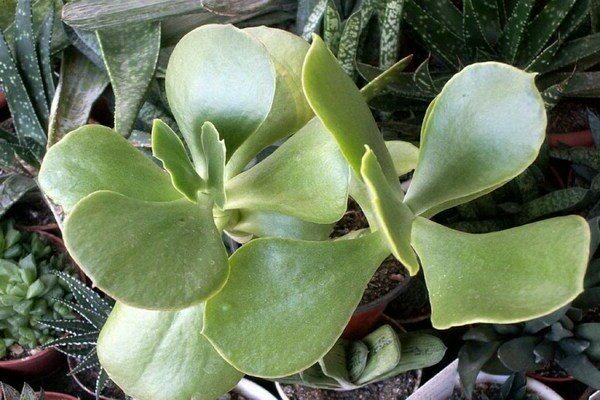

Cotyledon is transplanted in the same way as other indoor plants: at first every year, gradually increasing the size of the flower pot, and then every three years. The root system of cotyledon does not grow so much that the roots begin to crawl out of the drainage hole, but if the crown of the cotyledon has become larger than the diameter of the pot, then it is time to transplant the plant.
Succulents, like cacti, do not need nutritious soil (in natural conditions they grow on rather poor soil), the most important requirements for the soil are loose, light and stony. You can buy a special soil for succulents and cacti and add some fine expanded clay to it or prepare a soil mixture yourself. To do this, you need to mix the garden soil with sand and add fine or broken claydite. You can also add chopped coal or bone meal to this mixture.
General information, origin and description
Cotyledon is a herbaceous perennial succulent belonging to the Tolstyankovye family. The native land of the plant is Africa, where its range extends from Ethiopia to the Republic of South Africa.
The genus Cotyledon is not numerous and, according to various classifications, includes from 10 to 40 species of succulents growing in the form of rosettes or shrubs.
The foliage of cotyledons can be of various shapes, depending on the variety, but it is necessarily strong and fleshy. In some species, the color of the leaves is monochromatic; variegated varieties are also found. The surface of the plates is covered with edging or dense whitish bloom.
As they grow older, the stalks of cotyledons become woody, covered with brown bark.
They are found as miniature, 25-35 cm succulents, as well as 60-70 cm specimens. They grow slowly, giving a slight annual increase.
Flower growers like cotyledons for their rich external variety, they fit perfectly into any interior and are perfectly combined with other indoor vegetation, including non-succulent ones. Compositions of different types of cotyledons are especially charming.
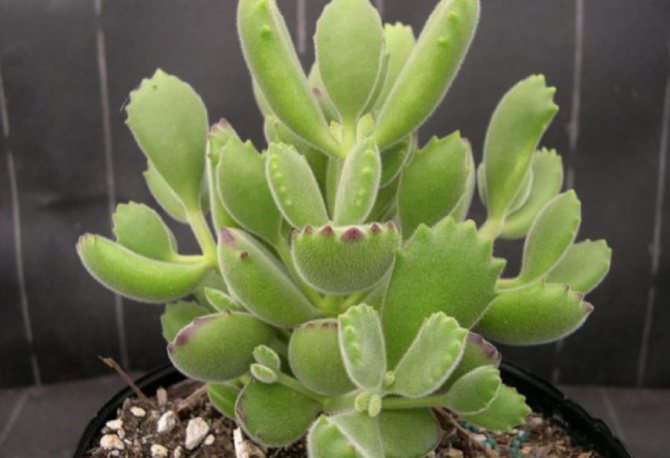

Cotyledon reproduction
If, after flowering, you managed to collect seeds, then you may well grow cotyledon from seeds that have excellent germination. But this method of reproduction is practiced by few growers, since it takes quite a long time to grow cotyledon from seeds.
Propagating a plant by rooting cuttings is much easier and faster. Apical cuttings can be placed in water, wait until roots appear, and then plant the plant and care for it in the same way as for an adult specimen. Or you can root them in wet sand (this will take three to four weeks), and only then transplant them into special soil suitable for the plant.
Cotyledon - succulents with fleshy leaves and beautiful bells


Family Crassulaceae - Tolstyanka.
Genus Cotyledon - Cotyledon.
Pig's Ear, Butter Tree, Cliff Cotyledon, Bear's Paw.
Cotyledon - plant care, planting and transplanting, reproduction.
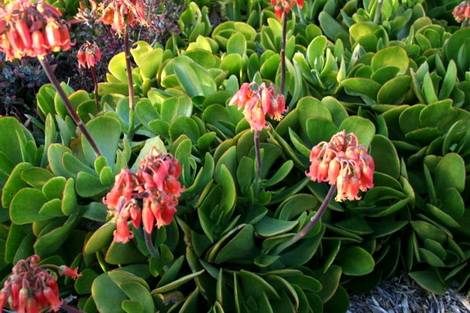

Cotyledon, origin and appearance.
In natural conditions, cotyledon is found in South and East Africa, Arabia and Ethiopia. Depending on the species, it can be in the form of a small bush, a tree (used to create bonsai) or creep along the ground in a pot, covering the entire surface. Young branched shoots are succulent and fleshy, later woody. The color of the stems ranges from light green to gray and reddish. The average plant height is about 25-65 cm, the annual growth is small. Has a fibrous superficial root system. It grows very slowly.
Stems and leaves are fleshy, colored from light green to reddish. A characteristic feature is that the stem grows stiff as it grows, becoming covered with a kind of brown bark.
It can be rosette, or it can be a small shrub. The leaves are either low-set, and the petiole is completely absent, or it is there, but very small. In this case, each subsequent pair of leaf plates on the shoot is located in relation to the previous one at an angle of 90 degrees. The shape of the leaf depends on the variety. So, for example, there are triangular, oval, rounded, rhombic or lanceolate leaves. Opposite fleshy leaves can be monochromatic or variegated, various shades of green, covered with a light downy or whitish bloom. Sometimes the outer edge has a contrasting liner.
In spring, cotyledons bloom, throwing out a long peduncle, on which inflorescences are collected. The flowers are outwardly similar to bells, and hang down from the peduncle. Cotyledon blooms with inflorescences of bright yellow, orange, red and purple. The flowering of almost all species is abundant and long-lasting and can occur at any time of the year, after which the formed capsules begin to ripen, in which there are a lot of small brownish spherical seeds.
Most species, including those grown at home, are poisonous plants. All care and transplantation manipulations are best done with gloves. Keep cotyledone out of the reach of children and pets.


Cotyledon, care and maintenance in a room.
Highly decorative bushes look great in pots and are capable of covering the entire soil surface. Some varieties are used to create bonsai. With sufficient lighting, it retains its decorative appearance for a long time.
You can not unnecessarily touch the leaves that have a bloom. It protects plants from rapid evaporation of moisture and its absence can disrupt the normal life of cotyledon.
It does not need formative pruning, but it is recommended to carry out a systematic pinching of tall plants in order to restrain their growth. Sometimes pinching young shoots stimulates bushiness. Dying shoots and leaves can be removed as needed. Elongated plants are pruned, the upper part can be rooted, the lower part of the stem can later give new shoots. Also, pruning is used when forming small trees. The plant normally perceives this procedure.
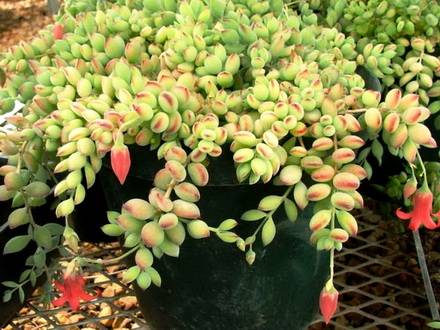

What should be the coverage of Cotiledon.
Lighting for cotyledon needs to be bright in order to maintain the natural color of the leaves and ensure the plant grows correctly. The plant will bloom only in good lighting on the south window. Direct sunlight, high-quality light, these are the necessary conditions for the development and growth of cotyledon. In summer, shading is necessary at midday, because if the light is too bright, the leaves can turn red and burns on them.
You can understand that there is little light by the elongated stems and shredded leaf plates. With insufficient illumination, the shoots become thin, the color fades, the leaves become noticeably smaller. The variegated leaves will begin to fade, turn yellow and fall off. For better flowering, it is desirable, starting in August, to provide the plant with a duration of illumination of no more than 9 hours (during the rest of the day, you can cover the plant with a dark cap).
Optimum temperature.
The temperature regime in the summer can not be controlled. Cotyledon tolerates both heat and small temperature changes well. During the spring and summer season, cotyledon is best kept outdoors, at temperatures of 20-25 degrees. In extreme heat, it is not recommended to put the pots on the south window, so as not to burn the delicate leaves. In winter, a lower temperature for the content of the succulent is recommended. The fact is that during this period the plant is resting, so the optimal temperature will be 10-15 ° C.
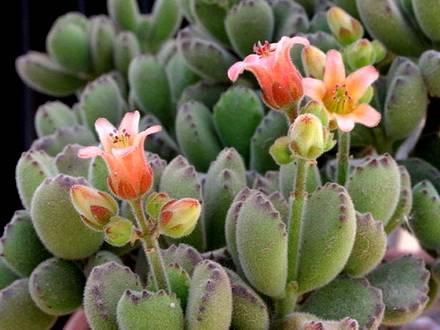

In what substrate is Cotyledon planted.
Can be planted in ready-made succulent mix purchased from a flower shop.
How to water Cotyledon.
Watering is needed moderate. Cotyledon is used to constant droughts. In the warm season, watered as the soil dries out 1-2 times a week. The most important thing is not to flood the succulent, it is subject to rapid decay of the roots. With the onset of autumn, watering is reduced and by November it stops altogether. In winter, cotyledon is transferred to dry content. In March, rare watering begins, no more than once every two weeks, and gradually increases to normal.
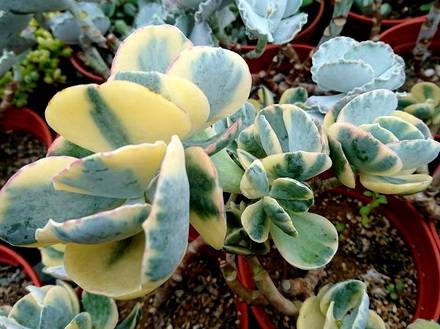

Air humidity.
There is no need to spray or artificially increase the humidity in the room.
Fertilizing Cotiledon with fertilizers.
Top dressing is not the most necessary procedure for this succulent. The fact is that cotyledon is adapted to the constant lack of nutrients associated with the poverty of the soil in its natural habitat. Therefore, the plant sparingly uses all the fertilizers it receives. In spring and summer, it is enough to fertilize once a month with ready-made liquid formulations for succulents, only to improve growth and splendor of flowering. Since September, feeding is stopped.
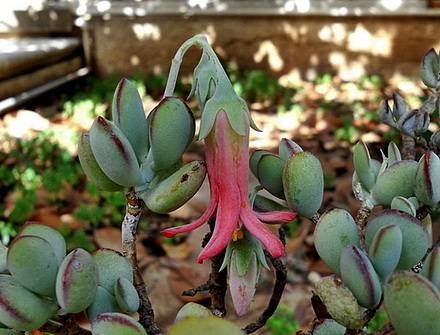

Planting and transplanting Cotiledon.
It has poorly developed roots and grows slowly without requiring frequent transplants. For young plants, an annual transplant is needed only if the rosette of leaves becomes wider than the diameter of the pot. They are transplanted in March until the pot reaches a diameter of 15 cm. Adult cotyledons are transplanted once every 2-3 years. You can only change the top layer of soil in the pot. The crown will tell you that it is worth replanting the plant. So, if its diameter has become larger than the diameter of the container, then it is worth transplanting into a larger pot. For transplant, use a ready-made substrate for succulents.To isolate the cotyledon neck from moisture, a layer of fine gravel can be poured around it.
Reproduction of Cotyledon by cuttings.
Propagates well by cuttings. To do this, in the spring - at the beginning of summer, cut off an 8-10 centimeter stem cutting with 2-3 leaves from the apical shoots of the current growth. Before planting, the workpieces must be air-dried for 1-2 days, while the cut site must be treated with crushed charcoal without fail.
Then the cutting is rooted in a wet sandy-peat substrate. The optimum air temperature for rooting is 16-20 ° C. Water in moderation. This method gives good results in 95% of cases. Rooted cuttings are transplanted into separate pots and placed under bright, diffused light. The tops of the shoots are pinched after the appearance of the third pair of leaves. Also propagated as a separate sheet.
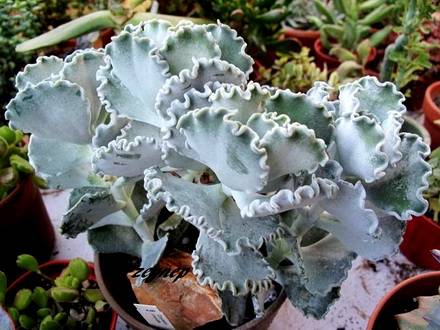

Reproduction by seeds.
You can use seeds. In small flat containers, seeds are sown directly on the substrate, lightly sprinkling them with sand on top. The seeds should be sown at a distance from each other. Seeds germinate well in a greenhouse, where they need to be regularly sprayed and ventilated, accustoming them to indoor conditions. Seedlings appear rather quickly - from one to three weeks. Grown up seedlings with 2-3 leaves are transplanted into single temporary pots in a substrate for succulents. It is very important, at the initial stage of caring for young growth, not to overmoisten the soil, otherwise root rot may appear.
Rest period.
Cotyledon needs winter rest. At this time, the recommended temperature is 15 degrees. At lower temperatures, cotyledone becomes soft and may die. In winter, cotyledon is transferred to dry content. Completely stopping watering until March. Warm wintering is not recommended for cotyledon, because in this case it may not start flowering.
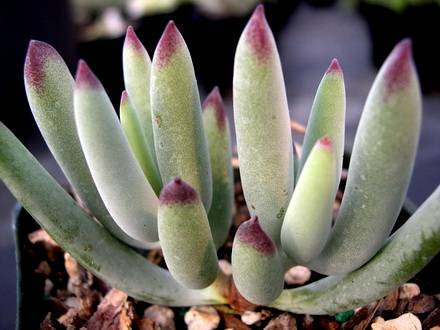

Diseases and problems in the care of Cotyledon.
Cotyledon is very rarely sick, and in most cases dies from root rot. Rot of the root system and base of the stem can occur from constant overflow.
Flowering plants are susceptible to powdery mildew (moldy and blackened areas on the leaves).
If the lower leaves turn yellow and fall off, most often this is a natural aging process of the plant. However, the lower leaves may turn yellow and dry out due to insufficient soil moisture.
In summer, plants can shed their leaves. In this case, they need to be placed in a well-lit place and stop watering.
Plants stretch strongly due to lack of light.
The slow growth of the plant can be associated with a lack of nutrition.
Popular types and varieties of Cotiledon.
The most common type of cotyledon is the rounded Cotyledon orbiculata. Round cotyledon blooms in July - August, wavy in March - June. Tubular flowers of various colors, often collected in paniculate inflorescences.
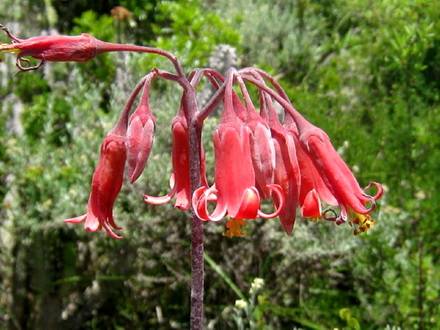

Cotyledon cacalioides - Cotyledon cacaloid, colloidal... A type of perennial shrub with a thin trunk thickened at the nodes, which reaches a height of about 25 cm. The length of gray-green, collected in a rosette, linear leaves is about 5 cm. The advantage of this species is unusual flowers resembling tongues of flame. The inflorescence itself is located on a long pubescent peduncle and has a paniculate shape with fiery red flowers drooping down, bell-shaped, in which the edges curl outward and upward. Panicle inflorescences of red, orange and yellow shades.
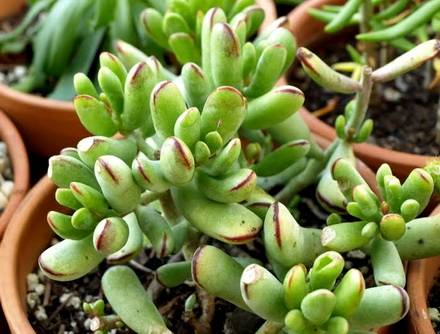

Cotyledon eliseae - Cotyledon Eliza... Perennial low compact, shrub up to 10-30 cm tall, with erect, weakly branching shoots. With age, the stems become woody with peeling bark. Basal rosettes can vary in shape. Leaves are smooth, fleshy, spatulate, 3-5 cm long, with a rounded end. Both sides are convex, glandular, sticky, green, red with reddish tints in the upper half. Edges can be with a red border, wavy.The flowers are bell-shaped, numerous, with 13-15 petals, with strongly curved ends of the petals, light pink, orange or red with dark stripes. The peduncle is brownish-purple, 2 mm in diameter. Blooms from May to June.
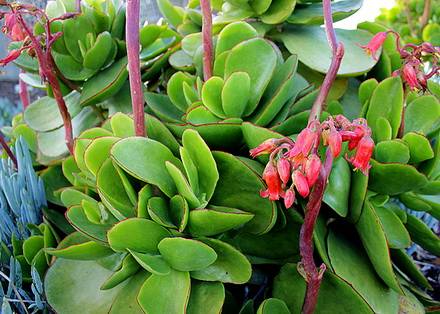

Cotyledon macrantha - Large-flowered cotyledon... Sprawling tall bush with straight thick stems, fleshy oval dark green leaves, which have a sharper edge and have a red edging. The average height of the shrub is from 50 to 80 cm. The inflorescence is paniculate with drooping bell-shaped red flowers, red on the outside and yellow-green on the inside. The petals of a linear shape are bent back. Peduncle about 25 cm.
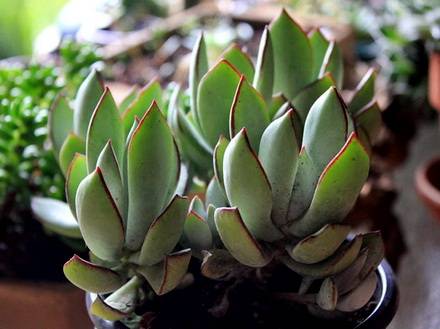

Cotyledon orbiculata - Round-leaved cotyledon... (Pig's Ear, Round-Leafed Navel-Wort). It grows in the form of a rather spreading bush, the height of which, in some cases, can reach 80-90 cm. Erect, densely branched fragile shoots. The growth rate is moderate. Leaves are opposite, solid, smooth, rather unusual rounded-triangular flattened shape, white-gray-green with a reddish-burgundy border along the edge, with a powdery wax coating. Their length varies from 7 to 13 centimeters. On the surface of the leaf plates and shoots there is a dense whitish bloom of wax, which is why the non-lignified parts of the bush are painted with a matte greenish-gray color shade. In the shade, the leaves will remain greener, and in full sun, foliage can develop its characteristic blue-gray hue. Do not touch the leaves to avoid damaging their coating. To maintain this coverage, plants should be watered from below.
The inflorescences are located on a thick peduncle of about 45 cm, painted in burgundy color. Bell-shaped flowers of red color are collected in spectacular umbrellas. The reddish-orange, pink flowers are rather small, the corolla tube is 1–2 centimeters long. They have a very strong mushroom odor. There are varieties with yellow flowers. Bloom in winter.
Cotyledon orbiculata v. ausana - leaves are hard, juicy, wide, blue-white with a red edging, covered with a dense waxy bloom, up to 5 cm long and wide, 3-4 mm thick, normally located compactly on shortened shoots.
Cotyledon orbiculata var. oophylla - bluish-silvery, medium-sized, cylindrical leaves with red tips, 3-4 cm long, up to 0.5 cm in diameter, located vertically on erect, rigid, branching stems, up to 20-30 cm high.It has shorter leaves, several ovoid, hence the name oophylla, and bright red flowers.
Cotyledon orbiculata flanaganii - leaves are bright green, cylindrical, 4-5 cm long, very juicy, flattened tip. They are initially located vertically on erect stems, up to 20-30 cm high.
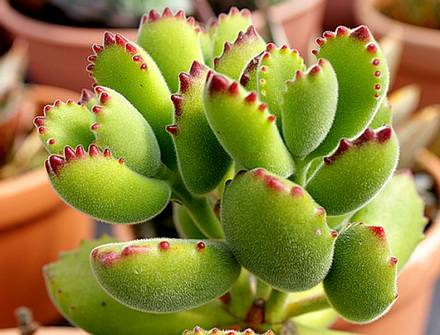

Cotyledon papillaris - Cotyledon papillaris, papillary... Shrub with creeping stems. Leaves are oblong-cylindrical, pointed, grayish-green, with a thin mealy bloom, reddening at the tips, up to 7 cm long. Located on erect, branching stems up to 20-30 cm high. The flowers are greenish yellow or reddish.
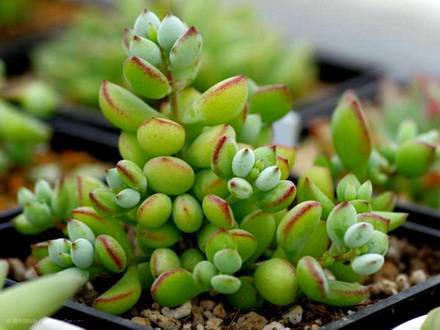

Cotyledon pendens... (Cliff cotyledon, Little cliff bells). Succulent multi-branched shrub, distinguished from others by thin, hanging shoots up to 60 cm long and inflorescences with distinct but short flower stems. Both stems and leaves are first covered with glandular hairs, becoming naked with age. The roots are fibrous, not succulent. Gray-green succulent succulent leaves, elliptical and ovoid, in opposite pairs, covered with a powdery bloom, the edge of the leaves is reddish, up to 2.5 cm long, up to 1.5 cm wide. The top of the leaf ends abruptly at a sharp point, the base is wedge-shaped. It has attractive orange-red bell-shaped drooping flowers. This species blooms in mid-summer.
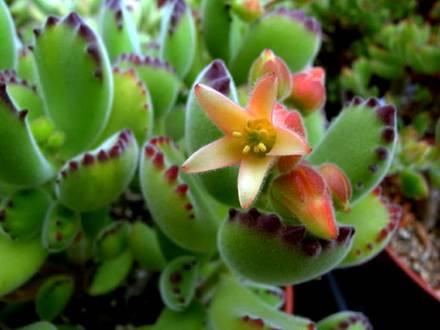

Cotyledon tomentosa - Cotyledon felt... (Bear's Paw, Kitten Paws, Woolly Cotyledon). (Bear Paw). A small compact bush up to 30 cm, with thin, pubescent stems with densely oppositely planted fleshy leaves, rounded to oblong-elliptical in shape. Branches profusely at ground level.Thick leaves with pubescence have an elongated shape, soft to the touch. Leaves are wide, convex, narrowed at the base. But the edge of the leaf has protruding red notches that resemble claws (a paw with claws). These barbs are arranged in a neat row and range from three to ten. There are bright green or yellow-green leafy forms with yellowish hairs, as well as gray ones with whitish hairs covering the leaves. The paniculate inflorescence blooms with red or orange bell-shaped flowers. Peduncle covered with thick hairs, 10-20 cm long.
Cotyledon tomentosa Ladismithiensis - Cotyledon Lady Smith. Its distinctive feature is a thicker silvery pubescence. There is also a very spectacular variety with variegated foliage.
Cotyledon ladismithiensis f. variegata - with creamy yellow spots on the foliage.
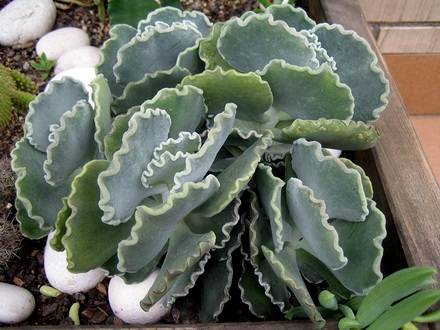

Cotyledon undulata - Cotyledon undulata, wavy... (Silver crown, Silver Ruffles). Sprawling shrub with straight, branched shoots up to 70-80 cm tall. The stem is thick, white. A distinctive feature and main highlight of this species is the fleshy foliage of a wide-rhomboid shape with a wavy white edge. The surface of the gray-white to blue-gray leaves has a slight mealy bloom. It blooms with numerous umbrella-shaped inflorescences. Along the high burgundy peduncle up to 25 cm tall, you can see white stripes, and an umbrella inflorescence is located at the top. The bright drooping flowers have the shape of bells painted in orange or red with white stripes, while the corolla tube reaches a length of 17 mm.
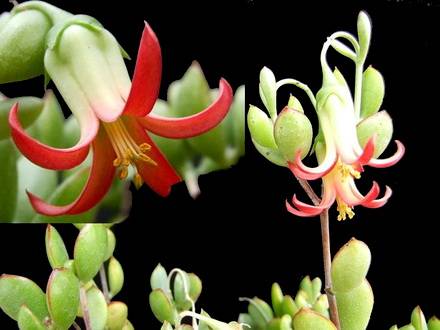

Cotyledon woodii - Cotyledon woodii... Synonym: Cotyledon ramosissima. It grows as an upright, branched shrub with a height of up to 120 cm. Young shoots are juicy and green. Old tree shoots have peeling. Green or gray and obovate flat leaves are up to 12 cm long, sometimes covered with glandular hairs. The base of the leaves is wedge-shaped, the upper edge of the leaves is reddish up to about half. The inflorescence is usually of single flowers, up to 7 cm long. The flower tube is orange to red, slightly tapering towards the mouth.
Cotyledon woodii Gamtoos - Forms vertically rounded bushes with sticky leaves.
Cotyledon woodii Green Eggs - forms upright shrubs up to 30 centimeters high. Glossy green leaves have a red border on top.
Cotyledon woodii Gray Eggs - Forms upright, rounded bushes with gray and smooth leaves.
Cotyledon woodii Konga - forms shrubs up to 10 centimeters. On green shoots, dull leaves covered with bloom.
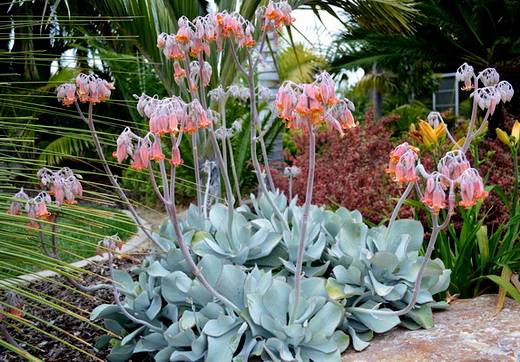

Possible problems and solutions
First of all, it should be noted that some plant species contain toxic substances, so it is better to carry out all manipulations with cotyledone with gloves. And also it is worth placing it so that small children or pets cannot get to the plant.
Cotyledon rarely gets sick, but sometimes gray rot can appear from excessive watering. In this case, it is necessary to cut off all the affected parts of the plant, and treat the healthy part with the fungicide two or three times with an interval of several days.
Of the pests for cotyledon, the mealybug is the most dangerous. If you find this parasite, then first try to deal with it with a folk remedy - moisten a cotton swab with alcohol or vodka and remove the pests. If this does not help, then you will have to resort to the help of insecticidal preparations (Actellik, Fufanon). And remember, if you find pests or signs of disease on a plant, then it must be isolated from other indoor flowers until it recovers completely.
If in the summer you take the plant out into the garden, then be prepared for the fact that snails and slugs will want to feast on its fleshy leaves.
Also, in the summer months, cotyledon leaves may partially fall off, but you should not worry - this is part of a natural process.
Possible problems
In case of excessive watering or insufficient lighting, the base of the stems and leaves can rot. In this case, watering is immediately reduced, the plant is placed in a more illuminated place. The damaged fragments are cut off, and the rest is treated with a fungicide.
Soft, wrinkled leaves are a sign of a lack of moisture. In this case, the watering of the plant needs to be increased slightly.
With a lack of light, cotyledon can begin to shed its leaves.
Of the pests, felt are sometimes found. You can remove such pests with a cosmetic stick, pre-moistened with alcohol. It is not recommended to use an insecticide in this case, as this can lead to shedding of leaves.


Varieties
Despite the large number of plant species, only four to five of them are the most popular among flower growers.
Cotyledon orbiculata. One of the most popular species, which in nature can grow up to 120 cm, but when grown indoors, it has a more modest size. Due to the dense wax coating on the leaves, they have a gray-green color, the shape of the leaves resembles a triangle with rounded corners. During flowering, the plant produces a very long burgundy flower stalk, on which small orange-red flowers are located (in some varieties, flowers are yellow).
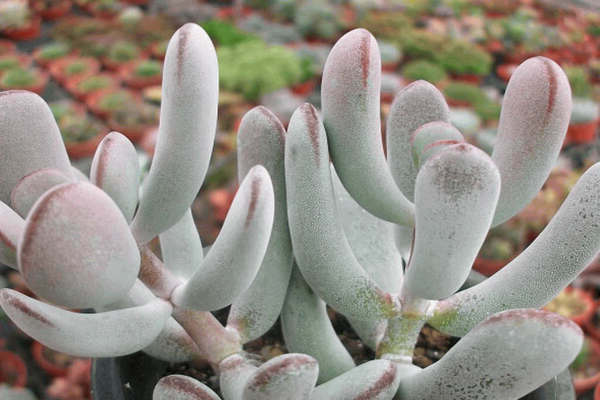

Cotyledon undulata. A very compact plant with large gray-green leaves, also covered with a waxy coating. The edges of the leaves are wavy, thanks to this and their shape, they resemble scallops. The flower stalk is burgundy with white stripes, and the shade of flowers can be yellow or orange.
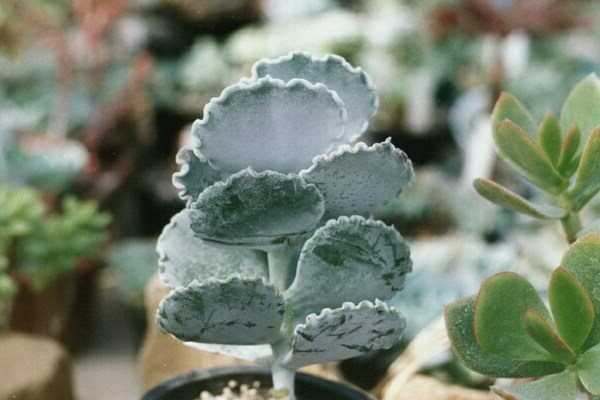

Cotyledon tomentosa. One of the smallest cotyledons no more than 15 cm high. The bright green leaves with burgundy teeth do not have a wax coating, instead they are covered with fluff. Such a plant blooms with orange-red flowers. Thanks to the contrasting color combination and amusing shape, the plant has received another name - growers jokingly call it "Bear's paw". One of the varieties of cotyledon tomentosa is Lady Smith. Outwardly, these plants are very similar, but "Lady Smith" has smaller leaves and thicker pubescence.
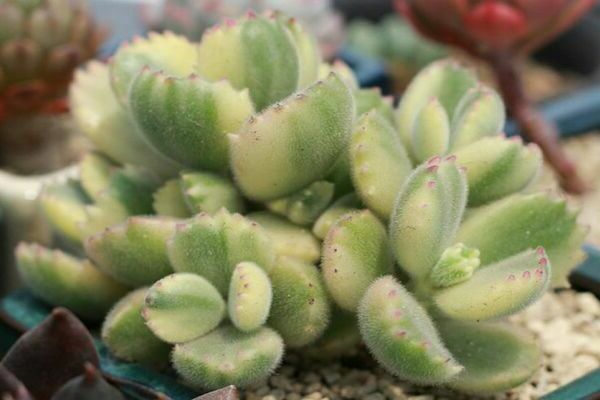

Cotyledon cacalioides... A compact shrub no more than 20 cm high. The plant has a strong lignified trunk, on it are rosettes of leaves with fleshy elongated grayish-green leaves with a contrasting edging. During flowering, on a peduncle about 30 cm long, small flowers are located, which can be yellow, orange or red in color.
Main types
Only 4 types of such a plant are especially popular with flower growers.
Round cotyledon (Cotyledon orbiculata)
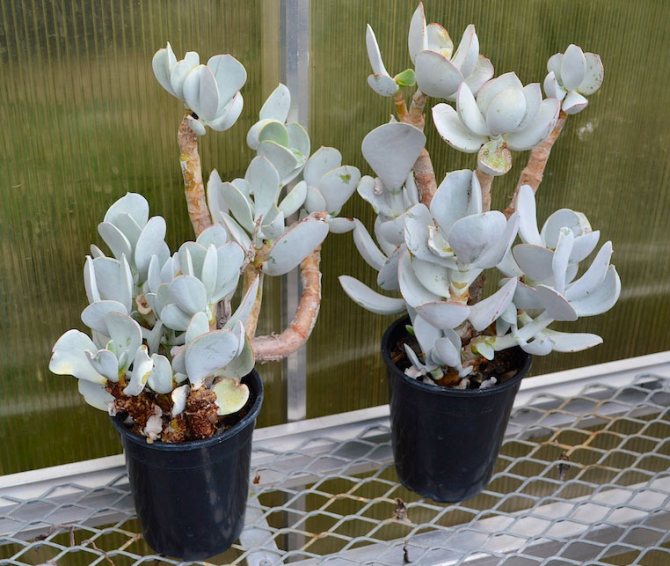

This type is most popular with flower growers. This shrub, growing in the wild, can reach a height of 90-130 centimeters. Whole, smooth leaves have an inversely ovate shape, which can rather be described as rounded-triangular. Their length varies from 7 to 13 centimeters. On the surface of the leaf plates and shoots there is a dense whitish bloom of wax, which is why the non-lignified parts of the bush are painted with a matte greenish-gray color shade. The edge of the leaf plate has a burgundy color. The reddish-orange flowers are rather small, the corolla tube is 1–2 centimeters long. They are placed on a long (up to 60 centimeters long), thick peduncle painted in burgundy color. There are varieties with yellow flowers.
Cotyledon undulata
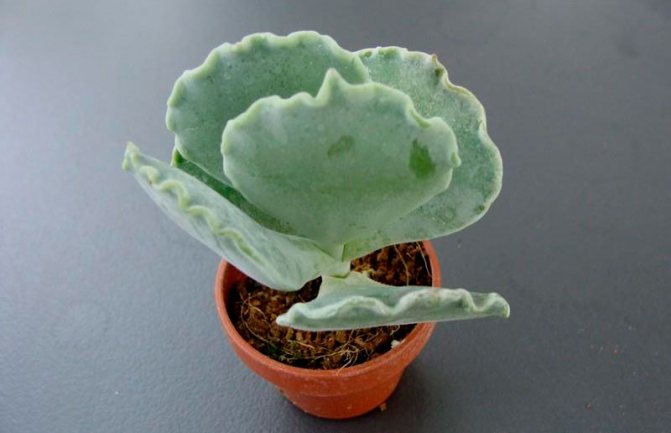

This shrub is quite compact, so its height does not exceed half a meter. The broad-rhomboid leaves have strongly wavy edges, making them very similar to scallops. This species also has a whitish and rather thick coating of wax on the surface of young leaves and stems, as a result of which they acquire a greenish-gray color. On the surface of the burgundy peduncle, the height of which can reach 25 centimeters, there are whitish stripes. The color of the flowers varies from orange to yellow, while the corolla tube reaches 16-18 millimeters in length.
Felt cotyledon (Cotyledon tomentosa)
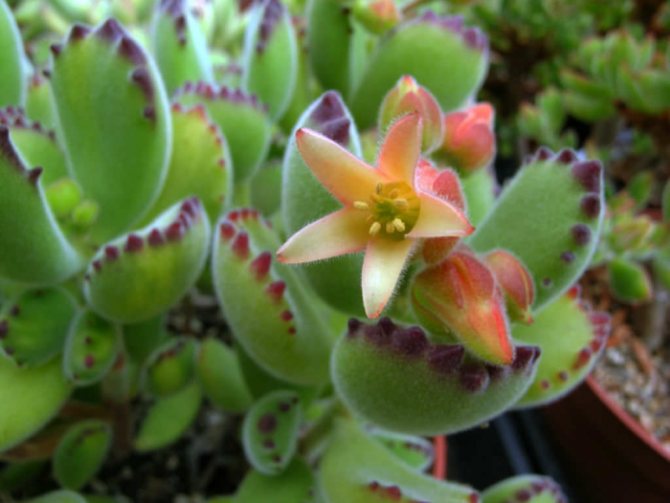

It is the smallest of all types, as its height can vary from 10 to 15 centimeters.This species stands out from most of the rest in that on its surface, instead of a bloom of wax, there is a dense pubescence. Plump, juicy leaves of an elongated-ovoid shape in the upper part have teeth similar to claws. The length of the sheet plate is 2.5 centimeters and the width is 1.2 centimeters. The appearance of such a plant influenced the appearance of the second name - "bear paw". The bell flowers are reddish-orange.
Lady Smith (Cotyledon Ladismithiensis)
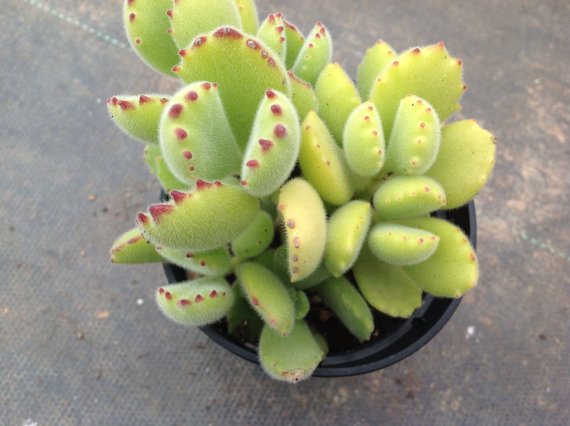

A variety such as Lady Smith's cotyledon (Cotyledon Ladismithiensis) is also quite common in the culture. Its distinctive feature is a thicker silvery pubescence. There is also a very spectacular variety with variegated foliage.
Cotyledon cacalioides
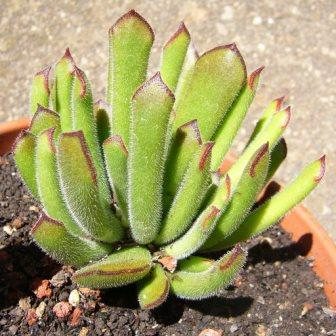

This shrub is rather short. So, its height, as a rule, does not exceed 20 centimeters. Linear, cylindrical, greenish-gray leaves in length reach 5-6 centimeters. They are part of rather dense leaf rosettes, which are located on thick woody trunks. The peduncle reaches a height of about 30 centimeters and there are many orange, yellow or red flowers on it.
Watering and moisture
The arid climate of nature has hardened cotyledon, it should be watered in moderation, after waiting for the soil to dry out. In winter, at low temperatures of rest, you can generally forget about watering it.
A good drainage layer in the pot is imperative.
Cotyledon can rarely be sprayed and washed; it has no complaints about humidity.
Water is taken soft at room temperature.
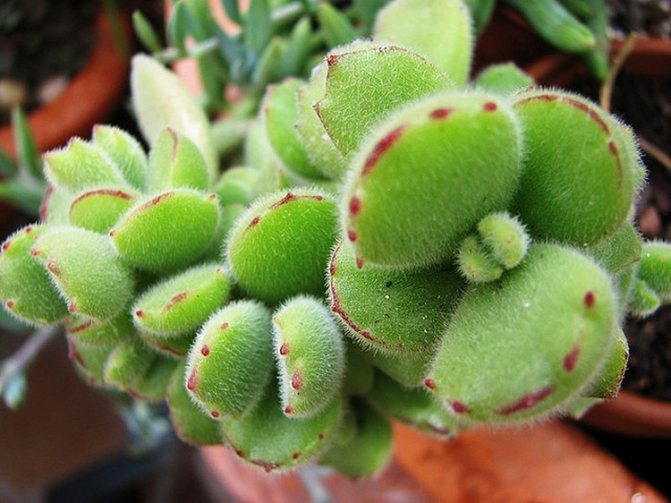

Felt cotyledon.
How to care for cotyledone at home
Lighting and air temperature
Caring for cotyledone at home is easy enough. The plant needs bright light and long daylight hours. Do not expose the pots with the plant in extreme heat to the southern windows, because the delicate leaves can get burned. From a lack of light, the motley color of the plant fades, the foliage may turn yellow and fall off partially.
Cotyledon will tolerate heat and slight changes in temperature normally. It is recommended to expose the flower to the open air in the summer: on the balcony or in the garden. In summer, the optimum air temperature will be in the range of 18-25 ° C. During the dormant period, in winter, it is useful to provide the plant with a temperature regime of 10-12 ° C.
Accustomed to frequent droughts in its natural environment, indoor cotyledon needs moderate watering. Between waterings, the soil should dry out completely, and excess moisture should flow out through the drainage holes. Dry air is not problematic for the plant. For cleanliness, occasionally spray or shower, but avoid moisture buildup at the base of the leaf outlets.
What kind of soil is needed for cotyledone?
Cotidelon is accustomed to depleted soils, is able to economically use nutrients. You can only feed it in the summer. It is enough to add a complex of minerals for succulents or cacti once a month. For planting, use a ready-made substrate for succulents or prepare yourself such an earth mixture: river sand, charcoal, gravel, leafy soil and clay-sod land.
It is necessary to transplant the plant as needed, when the rhizome grows strongly. Use shallow, wide pots with drainage holes. A layer of expanded clay or other material is laid on the bottom, and on top is a nutritious soil for succulents. Transplanted after watering, when the earth becomes damp. Remove the pot from the earthen ball and transfer it into a new spacious container. Old bushes can be pampered by replacing the top layer of the earth, but no more than 2-3 cm, trying not to disturb the roots.
Trimming and pinching
It is not necessary to trim the cotidelon regularly. Adequate lighting will preserve the decorative appearance of the bush. Pinching young shoots occasionally promotes bushiness.Pruning is also used to form small trees. The plant tolerates the pruning procedure normally.
How to form a bonsai from cotyledon
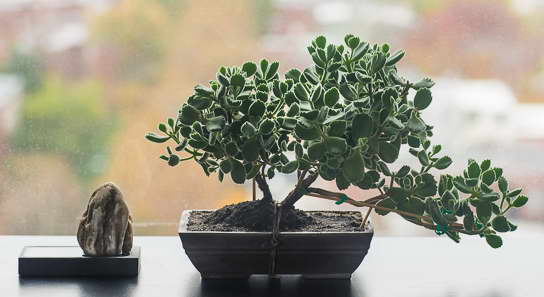

Bonsai from cotyledon photo
It takes patience to make a bonsai-style tree: the plant is formed into one shoot, the lower branches are cut, the upper shoots are left. When the succulent grows older, the formation of the crown begins: the branches are bent, tying sticks to them with ropes (so that they remain even) and weights (to deflect horizontally. A thick wire can also be used, which is wound around the stems and bent at its own discretion.) When the stems become woody, auxiliary materials are removed.
Diseases and pests
Cotidelon is resistant to diseases and pests. Only improper, excessive watering can provoke the appearance of rot. The affected areas need to be removed and the plant transplanted into clean soil without watering for the first time (several days). Very rarely a mealybug can attack - treat the plant with insecticides.
Necessary conditions for growing
Cotyledon is a succulent, therefore it requires the creation of an appropriate microclimate. It is important to choose the right place for the plant in order to minimize the impact of adverse factors. In nature, the culture grows in arid regions on depleted soils, moisture and food accumulates in fleshy leaf plates.
Most varieties are poisonous, unpretentious to care for, tolerate small changes in temperature well. Optimal growing conditions are created at + 20 ... + 25 ° C, during the dormant period it is desirable to maintain + 10 ... + 15 ° C. The soil and container for a houseplant should be selected correctly in order to avoid rotting of the root system.
Location and lighting
It is best to put a cotyledon flowerpot on the sill of a southern window open to the sun. Lighting is of paramount importance, the culture is not afraid of the sun, and in the shade the shoots stretch out, the leaves become smaller, the flowers are not formed.
The light regime during the dormant period should remain sufficient, despite the decrease in temperature and the cessation of watering.
Air humidity
Under natural conditions of growth, dry air is the norm for cotyledon, therefore, the culture does not require additional moisture. It is recommended to wipe the leaves from dust with a slightly damp soft cloth, do not allow water droplets to get inside the leaf rosettes. In summer, it is advisable to take a container with an indoor flower outside. Regular airing in spring and autumn is not necessary.
Requirements for soil and pot
Experienced gardeners recommend purchasing a special soil for succulents and cacti that meets the necessary requirements - a light, drained structure. If you want to collect the substrate yourself, you can make a soil mixture from turf, leafy earth and river sand. It is allowed to add a small amount of charcoal and bone meal. It is not recommended to introduce humus, vermicompost or other nutrient components, since an excess of nutrition will harm more than help the plant.
The capacity should not greatly exceed the earthen lump of cotyledon. It is enough to leave room for drainage and 3-4 cm for the substrate. The above-ground part is heavy, so the bush can be resilient with a ceramic pot. In addition, untreated clay allows excess moisture to pass through well. The container and natural components of the soil mixture must first be disinfected.
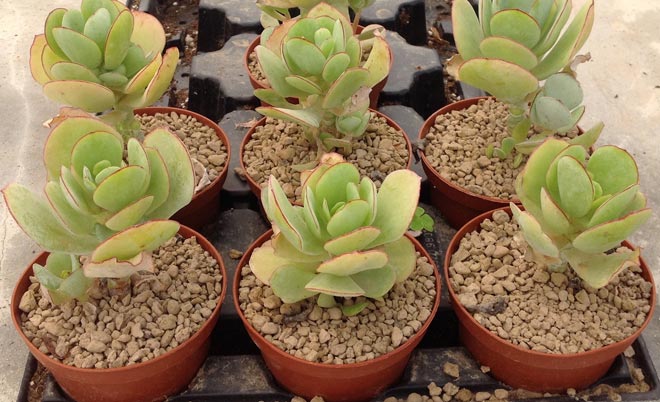

1. Seven Secrets of Success:
| 1. Growing temperature: all year round can be kept at room temperature between 18 and 26 ° C. |
| 2. Lighting: Well-lit location with a lot of reflected sunlight. Direct sunlight should fall on cotyledon in the morning and evening, daily |
| 3. Watering and humidity: Abundant, but rather rare watering, even in spring and summer - dry the substrate a few centimeters deep between waterings. In autumn and winter, just keep the soil from drying out completely. It is better not to increase the air humidity. |
| 4. Pruning: sanitary regular pruning with a sharp sterile instrument - removal of old leaves and peduncles with wilting flowers. |
| 5. Priming: perfectly drained, nutrient-poor substrates can be easily permeated. |
| 6. Top dressing: monthly liquid mineral fertilizers for succulent plants in half the concentration in the warm season. In autumn, fertilizing is reduced and in winter the plants are immersed in a dormant period, refusing to fertilize the flower. |
| 7. Reproduction: sowing seeds in spring, leaf and stem cuttings in spring and summer. |
Botanical name: Cotyledon.
Cotyledon plant - family... Crassy.
Origin... South Africa.
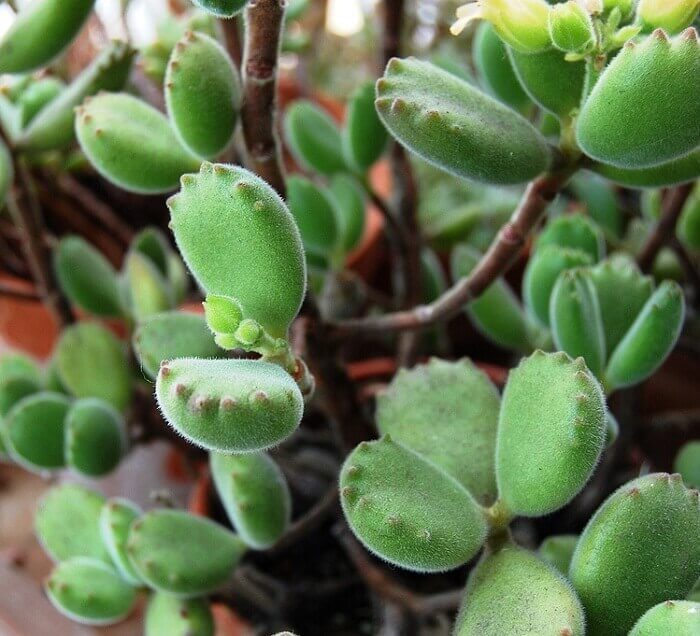

Description. Cotyledon - an extremely variable genus of perennial, compact, succulents, consisting of only 10 species. Individual plants have round, flat or long cylindrical cross-section, succulent leaves, located on small, brittle stems. The stems are sometimes smooth and covered with a thin bark that often flakes off; in other species, the stems may be pubescent. Some species form a rosette of large, corrugated leaves. Leaves can be light green, bluish green with a waxy bloom, or gray. Inflorescences appear on tall peduncles emerging from the center of the plant and bear, often hanging, attractive, bell-shaped flowers with greenish-pink, red, purple or orange petals accreted.
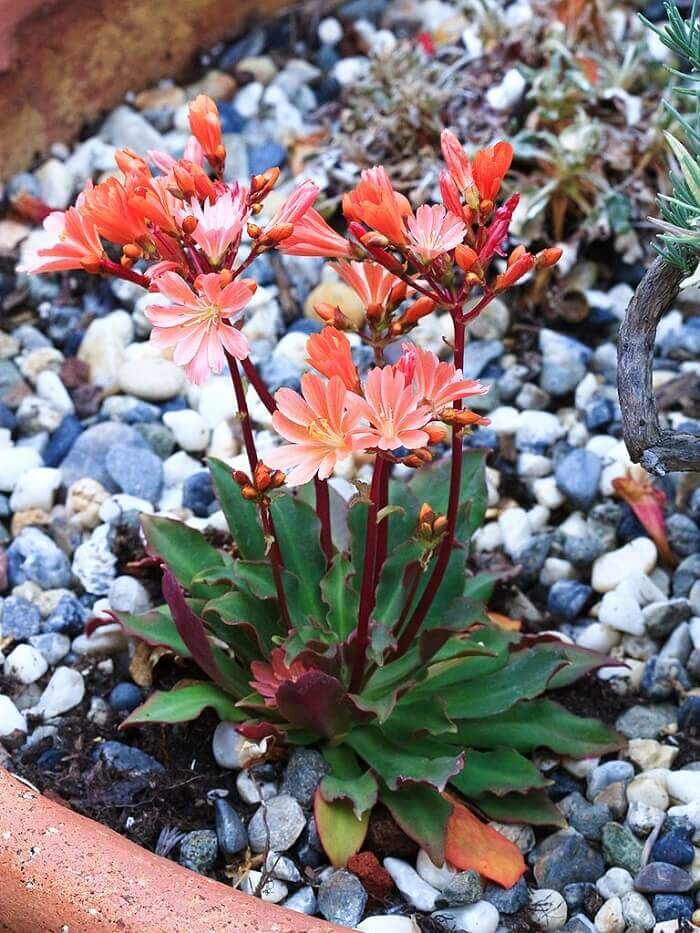

Height... The height of the cotyledon depends on the specific species and can range from 10 cm to 3 m.
Transplant timing and technology
The procedure is carried out in the spring. Cotyledon grows slowly, so you should focus on the filling of the flowerpot with the root system. At first, transplant once every 1-2 years, then every 2-3 years.
It is better not to touch a large plant so as not to break fragile stems and leaves. Wear gloves to avoid getting burned by the poisonous juice.
Take the pot more than the previous one by only 2-4 cm, carry out the operation by the transshipment method. There must be a drainage layer of at least 2 cm. Next, you need to pour 3-4 cm of fresh substrate, put an earthen lump with roots. Cover the space formed on the sides with earth. Water the plant, do not feed for about a month.
Diseases and pests, and how to deal with them
Cotyledon is very resistant to pest attacks. Most susceptible to mealybug damage. You can remove the pest manually using a damp cloth soaked in alcohol or treat with insecticides. Also, the use of insecticides is recommended if the plant has suffered from spider mites, scale insects or aphids.
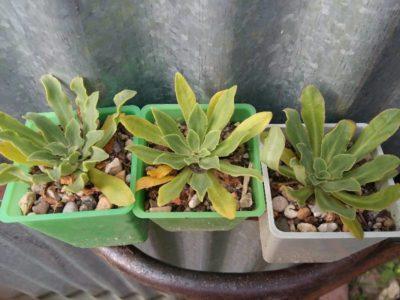

If the plant is taken out into the garden during the summer maintenance, there is a risk of damage from snails. The container with cotyledone should be protected from contact with garden soil and other plants. Rot on the leaves is the result of water getting on them. Shriveled brown leaves are the result of prolonged drying out of the roots with insufficient watering. Due to the lack of light, the plant can stretch a lot.
Slow growth is usually due to a lack of nutrition. When the lower leaves of the plant turn yellow and fall off, there is no cause for concern. This is the natural aging process of the plant. Root rot can occur due to constant overflow.
On a note. Only a transplant can save the plant, during which it is necessary to remove the damaged parts, rinse the roots and treat them with a weak solution of potassium permanganate. The same method will help in case of damage to the plant by the root worm.

